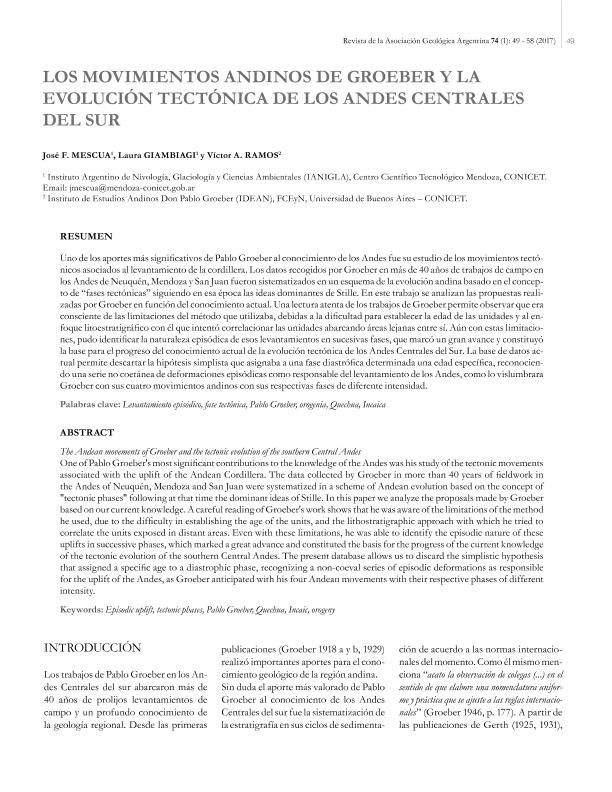Artículo
Uno de los aportes más significativos de Pablo Groeber al conocimiento de los Andes fue su estudio de los movimientos tectónicos asociados al levantamiento de la cordillera. Los datos recogidos por Groeber en más de 40 años de trabajos de campo en los Andes de Neuquén, Mendoza y San Juan fueron sistematizados en un esquema de la evolución andina basado en el concepto de ?fases tectónicas? siguiendo en esa época las ideas dominantes de Stille. En este trabajo se analizan las propuestas realizadas por Groeber en función del conocimiento actual. Una lectura atenta de los trabajos de Groeber permite observar que era consciente de las limitaciones del método que utilizaba, debidas a la dificultad para establecer la edad de las unidades y al enfoque litoestratigráfico con él que intentó correlacionar las unidades abarcando áreas lejanas entre sí. Aún con estas limitaciones, pudo identificar la naturaleza episódica de esos levantamientos en sucesivas fases, que marcó un gran avance y constituyó la base para el progreso del conocimiento actual de la evolución tectónica de los Andes Centrales del Sur. La base de datos actual permite descartar la hipótesis simplista que asignaba a una fase diastrófica determinada una edad específica, reconociendo una serie no coetánea de deformaciones episódicas como responsable del levantamiento de los Andes, como lo vislumbrara Groeber con sus cuatro movimientos andinos con sus respectivas fases de diferente intensidad. The Andean movements of Groeber and the tectonic evolution of the southern Central Andes One of Pablo Groeber's most significant contributions to the knowledge of the Andes was his study of the tectonic movements associated with the uplift of the Andean Cordillera. The data collected by Groeber in more than 40 years of fieldwork in the Andes of Neuquén, Mendoza and San Juan were systematized in a scheme of Andean evolution based on the concept of "tectonic phases" following at that time the dominant ideas of Stille. In this paper we analyze the proposals made by Groeber based on our current knowledge. A careful reading of Groeber's work shows that he was aware of the limitations of the method he used, due to the difficulty in establishing the age of the units, and the lithostratigraphic approach with which he tried to correlate the units exposed in distant areas. Even with these limitations, he was able to identify the episodic nature of these uplifts in successive phases, which marked a great advance and constituted the basis for the progress of the current knowledge of the tectonic evolution of the southern Central Andes. The present database allows us to discard the simplistic hypothesis that assigned a specific age to a diastrophic phase, recognizing a non-coeval series of episodic deformations as responsible for the uplift of the Andes, as Groeber anticipated with his four Andean movements with their respective phases of different intensity.
Los movimientos andinos de Groeber y la evolución tectónica de los Andes Centrales del Sur
Título:
The Andean movements of Groeber and the tectonic evolution of the southern Central Andes
Fecha de publicación:
02/2017
Editorial:
Asociación Geológica Argentina
Revista:
Revista de la Asociación Geológica Argentina
ISSN:
0004-4822
e-ISSN:
1851-8249
Idioma:
Español
Tipo de recurso:
Artículo publicado
Clasificación temática:
Resumen
Archivos asociados
Licencia
Identificadores
Colecciones
Articulos(IANIGLA)
Articulos de INST. ARG. DE NIVOLOGIA, GLACIOLOGIA Y CS. AMBIENT
Articulos de INST. ARG. DE NIVOLOGIA, GLACIOLOGIA Y CS. AMBIENT
Citación
Mescua, Jose Francisco; Giambiagi, Laura Beatriz; Ramos, Victor Alberto; Los movimientos andinos de Groeber y la evolución tectónica de los Andes Centrales del Sur; Asociación Geológica Argentina; Revista de la Asociación Geológica Argentina; 74; 1; 2-2017; 49-58
Compartir




